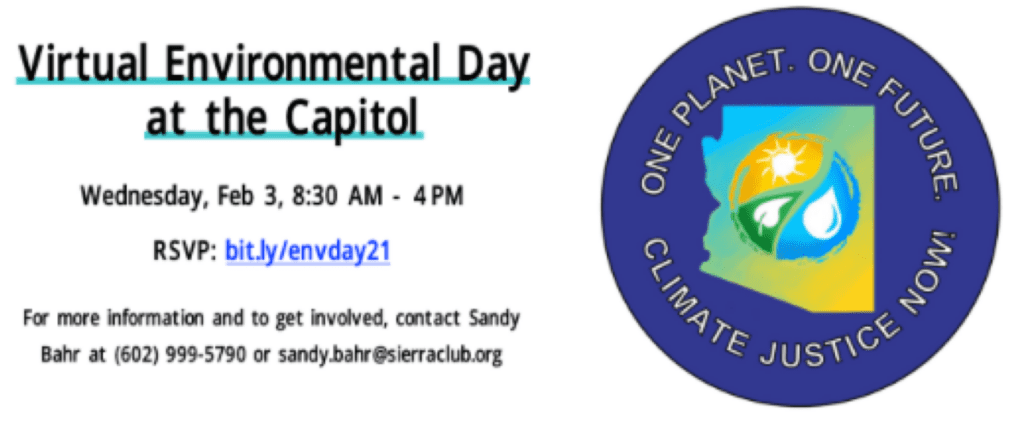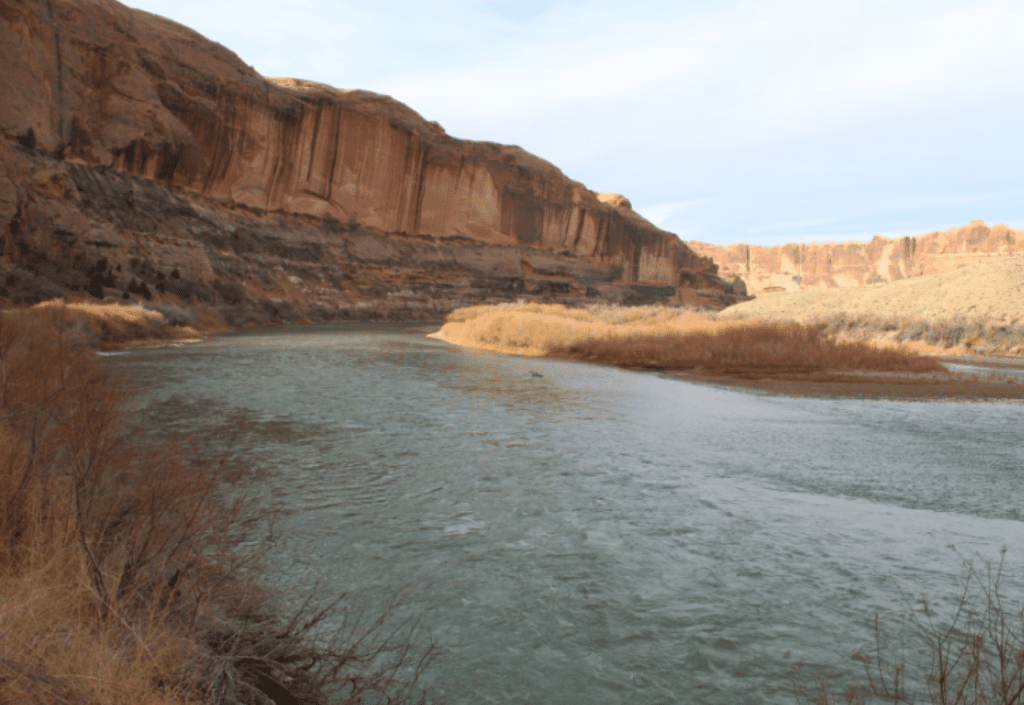Daniel Salzler No. 1087
EnviroInsight.org Six Items January 29, 2021
Feel Free To Pass This Along To Others
If your watershed is doing something you would like others to know about, or you know of something others can benefit from, let me know and I will place it in this Information newsletter.
If you want to be removed from the distribution list, please let me know.
Please note that all meetings listed are open.
Enhance your viewing by downloading the pdf file to view photos, etc. The attached is all about improving life in the watershed. If you want to be removed from the distribution list, please let me know. Please note that all meetings listed are open.
Enhance your viewing by downloading the attached pdf file to view photos, etc.
The attached is all about improving life in the watershed.
1. AZ Dept of Environmental Quaastewater Treatment Rulemaking.

During the meeting, ADEQ will provide an overview of the five-year plan, discuss the role of the On-site Wastewater Advisory Committee, provide information on how to volunteer for a technical work group and seek your input on the changes needed to update the existing rules.
For more information, contact:
Matt Ivers
Groundwater General Permits and Reuse Manager
[email protected]
602-771-6723
2. Environmental Day at the AZ Capitol: One Planet, One Future. Climate Justice Now! Join advocates from throughout Arizona in a meeting with state Legislators to promote Environmental protection and justice, climate action, lands and wildlife conservation, flowing rivers, democracy and more.

Register NOW by going online to https://act.sierraclub.org/events/details?formcampaignid=7013q000001b9DbAAI&mapLinkHref
3. Upper Colorado River Drought Plan Triggered For First Time. Increasingly bleak forecasts for the Colorado River have for the first time put into action elements of the 2019 upper basin drought contingency plan.
The 24-month study released in January by the Bureau of Reclamation, which projects two years of operations at the river’s biggest reservoirs, showed Lake Powell possib1ly dipping below an elevation of 3,525 feet above sea level in 2022. That elevation was designated as a critical threshold in the agreement to preserve the ability to produce hydropower at Glen Canyon Dam.
In a letter to water officials in Colorado, Utah, New Mexico and Wyoming, the Bureau of Reclamation’s Wayne Pullan and Jacklynn Gould said the “minimum probable” forecast triggers “enhanced monitoring and coordination,” and instructed states to identify point persons to take part in monthly planning calls. Those meetings have yet to be scheduled.
“It’s really about giving people an advanced warning,” said Eric Kuhn, former general manager of the Colorado River District, and one of the architects of the 2019 plan.
The forecast in question is called the “minimum probable” forecast, one of the more pessimistic possible futures on the river that supplies water to 40 million people across seven U.S. states and two in Mexico. But the model makes clear it’s plausible that Lake Powell could see rapid declines within the next two years, Kuhn said.

“We need a cushion, and time to react,” Kuhn said. “So the 3,525 (elevation) was put in as a way to give everyone time to think about what’s happening.”
If federal models show the reservoir’s elevation declining past that threshold under the “most probable” forecast, smaller reservoirs upstream in the four Upper Basin states could release water to prop up Lake Powell. The models don’t show that scenario as the likeliest to occur yet.
A parallel agreement in the river’s lower basin, which ties important water cutbacks to the level of Lake Mead outside Las Vegas, was implemented the year it was signed.
Under that agreement some users in Nevada, Arizona and Mexico have had their Colorado River water deliveries curtailed due to sustained dry conditions. Combined, Lakes Powell and Mead are forecast later this year to hit their lowest levels since the two reservoirs filled decades ago.
As exceptional drought conditions expanded to more than 65% of the watershed’s total land area in 2020, operational forecasts for the Colorado River have worsened dramatically. Between Oct. and Nov. 2020, Bureau of Reclamation models projected a possible one million acre-foot drop in Lake Powell’s water storage due to lagging snowpack totals and record-setting soil moisture deficits.
“That was the first glimmer we could be looking at this way earlier than we expected,” said Amy Haas, executive director of the Upper Colorado River Commission.
The drought contingency plans place much of the authority to direct the response in the Department of Interior Secretary. While Rep. Deb Haaland of New Mexico has been nominated for the post, the position is currently vacant. So too is the position of Bureau of Reclamation commissioner, which means much of the drought response coordination is happening at the regional director level, something the drought contingency plans allowed for, Haas said.
4. Lake Mead Ends 2020 At Elevation 1084’ – Bringing Tier Zero Operations In 2021. The hydrology in 2020 began with optimism and promise, but ended with a disappointing runoff and inflow to Lake Powell. We will continue to operate in Tier Zero in 2021, as we did in 2020. Tier Zero operations include a reduction of 192,000 acre-feet to CAWCD, impacting supplies available for water banking, aquifer replenishment and a modest reduction to CAP’s agriculture supplies. Although Tier Zero is good news for 2021, it’s important to note that the disappointing inflows in 2020 have pushed the outlook for 2022 (which will be announced by the U.S. Bureau of Reclamation in August 2021) toward the possibility of larger reductions under potential Tier 1 conditions.
Here’s a brief recap of the 2020 conditions in the Colorado River Basin:
- 2020 was the first year operating under the Drought Contingency Plan (DCP) Tier Zero,
- The end of the snow accumulation season showed a near normal snowpack across the Upper Colorado River Basi which begins at Lake Mead elevation 1090′ and extends to 1075′
- Thanks to DCP reductions and continued conservation and storage contributions, Lake Mead continued to remain stable, ending 2020 at 1084′
- The April 2020 runoff projections showed inflows to Lake Powell on the order of about 80% of the long-term median. These projection reflected the influence of dry fall 2019 conditions, which were projected to reduce the conversion of snowpack to runoff in spring-summer 2020.
- The hot, dry spring and sumer 2020 further depleted the runoff into Lake Powell. By the end of the runoff season, the inflows to Lake Powell were about 55% of the long-term median
- The hot and dry conditions persisted into the fall 2020.
The reduced inflows to Lake Powell in 2020, absent normal inflows in the spring and summer of 2021, will trigger reduced releases from Lake Powell in water year 2021 and 2022, causing a drop in Lake Mead elevations. This could result in Tier 1 (1075 – 1050’) for 2022 operations.
Under Tier 1, Arizona would be required to reduce uses by 512,000 acre-feet, to Arizona’s 2.8 MAF entitlement, borne almost entirely by CAWCD. This reduction, almost 30% of the CAP supply, is significant and will impact CAP’s many water users. However, there would be no immediate impact to municipal and tribal water supplies under a Tier 1 shortage. Due to the Arizona Implementation Plan that was developed in 2019 for DCP, plans and agreements are in place to manage these reductions within the state. The Tier 1 reductions would be partially mitigated through the implementation of several innovative shortage-sharing and mitigation agreements, which would eliminate water banking and replenishment and severely curtail the agriculture supply. The cooperation and collaboration developed in the Arizona DCP process continues to benefit Arizona water users, even in the face of potentially deeper reductions in 2022.
The potential Tier 1 conditions in 2022 are far from certain. As we have seen and experienced over previous years, you never know what a year can bring! Source: CAP
5. Nutrition: Do You Really Know The Bread You Eat? It might be because many of us are working/staying at home these days, but a national survey of grocery store sales has bread being one of the more significant sales drivers. So do you know what your buying? Here’s a guide:
Wheat Bread
“Wheat“ doesn’t mean it’s a whole-grain bread. Look for the words “100% whole wheat” or “100% whole grain.”
Multigrain: “Multigrain” (or “7-grain,” “12-grain” and the like) also could just mean different kinds of refined grains. And as for “natural” and “artisan,” they’re imprecise.
Gluten-free: If you are not sensitive to gluten, there may not be any health benefit to switching to these breads, which can be expensive, less nutritious and come in smaller loaves.

Made with ancient grains: This refers to such whole grains as millet, amaranth, teff, kamut and spelt. Breads made with these grains may be healthier, or they may be mixed with less-healthy refined flours. Check the ingredients label.
Diet: Reduced-calorie bread often means fewer nutrients and more fillers, like cellulose. Avoid “diet” labels and simply choose a bread under 80 calories and with at least 2 grams of fiber per slice
Color: Low-nutrition breads are sometimes dyed brown to look healthy, and some white breads may contain healthier whole-grain flours. Read the label to determine nutritional value.

Serving size: Most bread packages serving size list the nutrition information as one slice, but we consume two slices at a time. If you’re having a PB&J for lunch, you’ll need to double what’s on the label to see the number of calories, fats and carbs you’re consuming.
Fiber and total carbohydrates: “The simplest way to spot a good bread is to look at total carbohydrates and fiber,” says Los Angeles–based nutritionist Ilana Muhlstein. “You want to have at least one gram of fiber per 10 grams of total carbs. The more fiber the better.”

Azodicarbonamide: Many breads include multisyllable ingredients like azodicarbonamide, a dough conditioner that some fast-food chains have removed from their breads over health concerns.
High-fructose corn syrup: Yeast needs sugar to create the carbon dioxide that makes the bread rise. But there’s one sweetener you should avoid: high-fructose corn syrup. Studies have linked it to diabetes, fatty liver, high blood pressure and obesity. Source: AARP Bulletin October 2020.
6. Shade Tree Webinar Events Coming In February For SRP Customers. Spring is right around the corner and it is one of the best times of the year to plant trees in your yard. What’ even better is free trees Join a free webinar and receive two shade trees for your home. Plus you will learn how to best select, plant and care for your trees. The event is free to ttend but space is limited to attend. Sign up at srpnet.com/shadetrees.
Upcoming Webinars:
Saturday February 13th at 10:00 a.m.
Wednesday February 24th at noon
Saturday March 6th at 10:00 a.m.
Copyright EnviroInsight 2021
